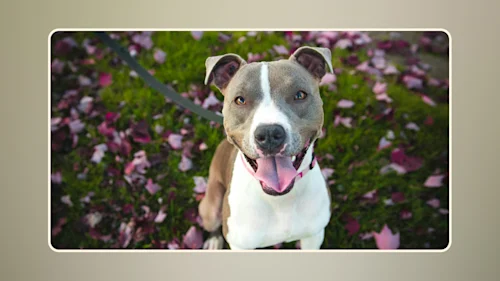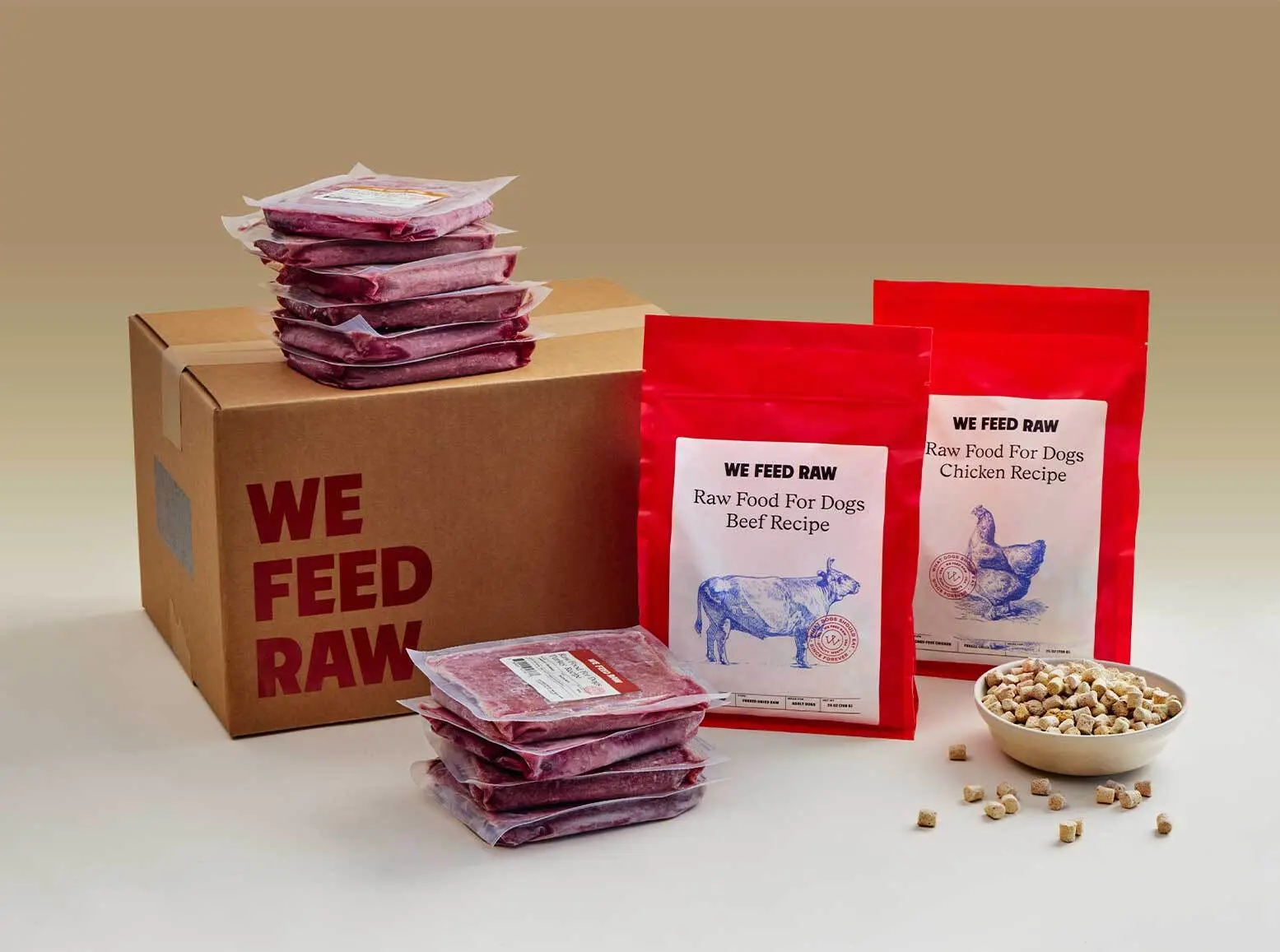
What’s the Best Dog Food for Pitbulls?
Table of Contents
Whether you just brought home a puppy, recently rescued an adult, or want to make sure you’re already feeding your dog the best, it’s always a good idea to look into the best dog food for Pitbulls. With their stocky build and propensity for allergies, Pitbulls have unique nutritional needs.
Read on for information about Pitbulls, their nutrition needs, and the best dog food for Pitbulls of all ages.
What Is a “Pitbull”?
While the term “Pitbull” or “Pit Bull” may refer specifically to the American Pit Bull Terrier, it is more often used as a generic term for a group of dogs with similar characteristics: a stocky, muscular build with short hair and large, square heads.
Dog breeds typically characterized as Pitbulls include the American Pit Bull Terrier, the Staffordshire Bull Terrier, the American Staffordshire Bull Terrier, the American Bulldog, and the American Bully.
American Pit Bull Terrier
Not recognized as an official breed by the American Kennel Club (AKC), American Pit Bull Terriers (APBT) vary widely in size and can weigh anywhere from 30 to 85 pounds as adults. APBTs need LOTS of socialization and training as puppies, but they’ll reward you with 12-16 years of love and devotion if you put in the hard work.
Staffordshire Bull Terrier
Also known as Staffies, Staffordshire Bull Terriers are much smaller than APBTs, maxing out at 24-38 pounds. Fond of digging and chewing when left to their own devices, these dogs prefer spending as much time as possible with their humans. They need lots of exercise and training but can be wonderful companions for children.
American Staffordshire Bull Terrier
Considered a mid-sized dog at 40-60 pounds as adults, American Staffordshire Bull Terriers are extremely strong for their size and need firm but loving training to prevent dragging people on walks. Am Staffs like to stay busy and are excellent at agility, nose work, and other dog sports. Their average lifespan is 10-15 years.
American Bulldog
The largest of the Pitbull breeds, the American Bulldog can weigh as much as 120 pounds when fully grown. Most recently bred for use as farm dogs, the American Bulldog wants to be active alongside its humans all day long and won’t be happy cooped up alone in an apartment all day. With plenty of exercise and attention, the American Bulldog can live up to 16 years.
American Bully
The newest Pitbull breed, the American Bully was developed in the 1990s by combining the American Pit Bull Terrier and the American Staffordshire Terrier. Some lines of American Bully also contain other breeds. There are 5 categories of American Bully—classic, extreme, extra-large (XL), standard, and pocket, leading to a tremendous variation in size. Adult weights typically range from 70 to 120 pounds.
Common Pitbull Health Issues
Like any dog breed, Pitbulls are prone to certain health conditions, including:
•Hip dysplasia and other joint problems
•Skin problems
•Cataracts
•Obesity
•Diabetes
•Liver disease
•Bloat
•Thyroid problems
•Heart disease
A high-quality, species-appropriate raw diet may help prevent or ease some of these health issues, especially since We Feed Raw is so good at helping dogs reach and maintain a healthy weight.
Pitbulls and Food Allergies
Pitbulls are prone to allergies of all kinds, but they’re especially prone to food allergies and intolerances. Food intolerances typically trigger digestive issues, while food allergies trigger an immune response and may cause symptoms like:
•Itchy skin
•Red eyes
•Hair loss
•Sneezing
•Eye discharge
•Recurrent ear infections
•Leathery skin texture
•Skin rashes
•Oily or scaly skin
•Pigmented skin
•Secondary bacterial or yeast infections of the skin or ears
The most common Pitbull food allergies include:
•Wheat
•Soy
•Corn
•Dairy
•Eggs
•Beef
•Chicken
•Lamb
We Feed Raw contains no wheat, soy, corn, dairy, or eggs, and we have 6 protein options to choose from, making it an excellent choice for Pitbulls who struggle with food allergies.
Dog Nutrition Basics
Before looking at the specific nutritional needs of Pitbulls, let’s look at some dog nutrition basics.
What Are the AAFCO Guidelines for Dog Food?
The Association of American Feed Control Officials (AAFCO) came up with a set of guidelines for what nutrients dog food must contain to be considered “complete and balanced.” AAFCO recommends at least 18% protein and 5% fat for adult dogs, and a minimum of 22% protein and 8% fat for puppies and lactating females.
Any food that doesn’t meet these bare minimum requirements must be labeled “for supplemental feeding only.”
But you don’t want to feed your dog a bare-minimum-quality food that will simply keep them alive, right? You want to give your pup the very best, like the complete and balanced patties from We Feed Raw.
Our food contains high-quality, species-appropriate, human-grade meat (plus organs, bones, vitamins, and minerals) your dog needs to THRIVE, not just survive.
Do you know what our food DOESN’T contain?
•Filler ingredients with no nutritional value that bulk up the food at a low cost
•Artificial colors, flavors, or preservatives
•Mystery meats from unknown origins
Avoid Unidentified Meat Meals and Animal By-Products
Cheap dog foods will include sketchy ingredients like generic “poultry meal,” “bone meal,” or “animal by-products” that could come from any animal, including:
•Dead zoo animals
•Roadkill
•Euthanized pets
•Diseased or dying livestock
•Feathers, fur, beaks, claws, and hooves
Whole meat from a named animal should always be the first ingredient of your dog’s food, and We Feed Raw takes that up a notch by using USDA, human-grade meats from reputable suppliers in the United States and New Zealand.
Nutritional Needs of Pitbulls
Now that you have an idea of a dog’s nutritional needs, let’s take a closer look at what Pitbulls need to live their best life.
High-Quality Protein
As a muscular dog breed, it’s especially important for Pitbulls to have a lot of high-quality protein in their diet. Most kibbles bump up their protein levels using lentils, soy, animal by-products, or other low-quality protein sources.
But dogs are carnivores, and their digestive system is specifically designed to extract the bulk of their nutrients from meat.
Healthy Fatty Acids
The key to healthy skin and a shiny coat for a Pitbull is to eat a diet rich in fatty acids, which get destroyed in the process of making kibble but are plentiful in our complete and balanced recipes.
Avoid Fillers and Artificial Preservatives
All dogs should avoid eating food packed with fillers and artificial preservatives, but it’s especially important for Pitbulls since they are so prone to allergies. The fewer ingredients in your Pitbull’s food, the better.
Mind Their Weight
Because of their stocky shape and voracious appetite, Pitbulls are prone to obesity, along with all its associated health risks, such as diabetes, pancreatitis, heart problems, joint issues, and much more. Your Pitbull should have an hourglass shape when viewed from above along with a visible tuck-up when viewed from the side. You should also be able to easily feel their ribs.
Free of the carbohydrates that are frequently responsible for weight gain, We Feed Raw can help dogs lose weight and keep it off.
Most Pitbulls Aren’t Considered “Large-Breed Dogs”
While some American Bulldogs and American Bullies can get large enough to be considered “large-breed dogs,” most Pitbulls don’t fall in that category, so you may do your dog a dis-service if you choose to feed them a diet designed for large-breed dogs.
That said, We Feed Raw meets AAFCO nutrition standards for dogs of all life stages, including large-breed puppies, so you can choose our food regardless of how big your Pitbull is or will grow to be.
Prevent Gulping and Gobbling
Pitbulls LOVE to eat, which can cause gulping or gobbling their food down as quickly as possible. In the best-case scenario, all the air they swallow gets released from one end of their body or the other, even if the smell clears a room. In the worst-case scenario, their stomach can turn on its axis, cutting off blood circulation to the rest of the digestive tract, a very serious condition called bloat.
One great thing about our food is that it’s easy to put on lick mats or into enrichment toys like Kongs or Toppls. Whether served right away or frozen for a few hours, these devices help slow down fast eaters, preventing gas from building up in their stomach as they eat.
Should Pitbulls Eat Grain-Free or Grain-Inclusive Food?
While the FDA spent a few years investigating a potential link between grain-free food and dilated cardiomyopathy (DCM), a serious heart condition, they recently announced that they would stop giving any updates on the investigation because of a lack of data connecting grain-free dog food and DCM.
In fact, they found a connection between the INCLUSION of lentils and other “pulse” ingredients and an increased risk of DCM rather than any connection to grain-free diets.
With their allergies, Pitbulls often do best on grain-free diets, and We Feed Raw is naturally grain-free. Unlike kibble companies, we don’t need to add starchy filler ingredients to bind our food together, meaning our food is free of grains, pulses, potatoes, and any other ingredients that may be linked to DCM.
FAQs
What Is the Best Dog Food for Pitbulls?
While there is no single best food for all Pitbulls, the complete and balanced, human-grade meat recipes from We Feed Raw qualify as one of the best, if not the best, food for most Pitbulls. Find out how much it would cost to get your Pitbull started on a raw diet here.
What Is the Best Puppy Food for Pitbulls?
Since our food is complete and balanced for dogs of all life stages, including large-breed puppies, We Feed Raw is perfect for Pitbull puppies. In fact, research shows that puppies fed a raw diet are less likely to develop atopic dermatitis and inflammatory bowel disease as adults.
Get your Pitbull puppy started on We Feed Raw here.
When Should You Switch a Pitbull From Puppy to Adult Food?
Puppies can start eating a raw diet as soon as they wean from their mother’s milk, and We Feed Raw can grow with your puppy all the way through their lifetime. However, if you feed a puppy kibble and want to switch to an adult formula, wait until your Pitbull is fully grown, usually around 18-24 months, before making the switch.
What Is the Best Dog Food for Pitbulls With Skin Allergies?
The best dog food for Pitbulls with skin allergies is a limited-ingredient diet that doesn’t contain common dog food allergens. We Feed Raw has 6 protein options to choose from—venison, duck, turkey, lamb, chicken, and beef—making it easy to avoid your Pitbull’s allergy triggers.
What Is the Best Dog Food for Pitbulls to Gain Muscle?
The best dog food for Pitbulls to gain muscle is one that’s high in protein and fat and low in carbohydrates. We Feed Raw fits that bill perfectly. Find out how much it would cost to get your Pitbull started on We Feed Raw now.
What Is the Worst Dog Food for Pitbulls?
The worst dog food for Pitbulls is anything that contains cheap fillers, animal by-products, artificial colors, and tons of carbohydrates.

Our Meals Change Lives.
(Theirs + Yours.)
See health improvements from our raw meals in as little as 1 week.
